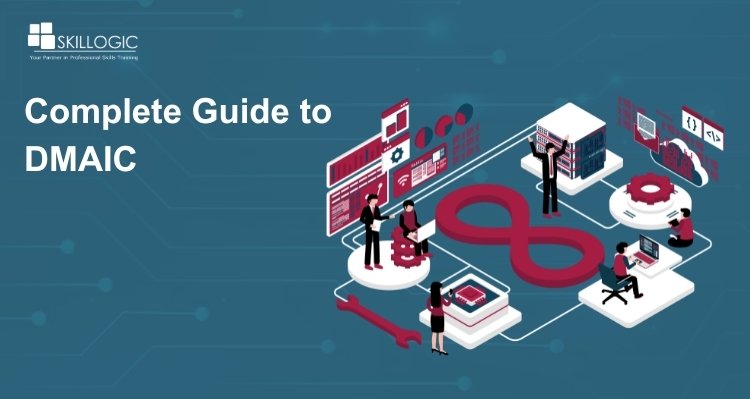Complete Guide to DMAIC

Every project has its own special challenges and obstacles to overcome, as any project manager is well aware. Finding the process improvement methodology that works for you and your team can be difficult when there are so many to adopt into a business.
The DMAIC process, a branch of the Six Sigma technique, was developed in the industrial sector and is best recognised for removing waste from projects. The DMAIC approach, which is highly rigorous and is preferred by engineers, was created to assist businesses in producing goods with almost zero defects.
What exactly is DMAIC, and why is it so effective? Read about its five steps below, if you are new to continuous improvement or simply want to test out a new technique. We'll go over each of the processes and discuss why this method is so well-liked.
What Is DMAIC?
DMAIC means :
- Define
- Measure
- Analyze
- Improve
- Control
DMAIC is a data-driven improvement cycle created to be used in business processes in order to identify and address flaws or inefficiencies that, in particular, lead to output defects. Using DMAIC aims to enhance, maximize, or stabilize current processes.
Read these articles:
5 Stages Of DMAIC
The DMAIC methodology is frequently used to produce "breakthroughs" in an organization as a component of a wider Lean Six Sigma programme. A team of subject matter experts and a Lean or Six Sigma leader known as a Black or Green Belt are appointed to each project.
Senior management of a company, led by a Six Sigma Black Belt, chooses a project team to address a recognized problem. The team follows the DMAIC approach, consisting of five steps, utilizing relevant DMAIC tools at each stage as outlined in the project charter.
- Define: In this initial step, we will establish the project's goal as well as the customers and their internal and external deliverables. This phase's main goal is to choose high-impact projects and measurements that will demonstrate the project's success. During this stage, questions such as who the target audience is, what they need in terms of goods and services, and what they anticipate, are raised. Also, the project's boundaries are established. During this phase, it is also necessary to map out the process flow, as well as the start and stop points.
- Measure: The present process must be documented at this DMAIC phase two. Validating the measuring methods and evaluating the baseline's performance are also included here. The process for figuring out the shortage via a customer survey is identical to this one. In this stage, we gather information from many sources to identify the different kinds of problems and metrics. Basic Pareto charts, process capability measurement, Gage R & R, and process flowcharts are the most crucial tools that can be employed in this phase.
- Analyze: Filtering out the most important causes of the Critical to Quality Characteristic, or CTC metric, for analysis is the main goal of the analysis phase. Typically, there shouldn't be more than three factors that need to be under control for an intervention to be effective. More than three causes indicate improperly performed critical cause isolation. Another explanation for this could be that the project's objective is overly ambitious. This stage requires you to determine whether there is a performance gap between the target performance and the actual performance. It is also necessary to pinpoint the causes of variation and potential areas for improving priority. Many methods, including scatter diagrams, hypothesis testing, multivariate analysis, time series plots, fishbone diagrams, histograms, and Pareto charts, can be utilized during this phase.
- Improve: This fourth step of the DMAIC architecture makes sure that all of the causes found during the Analyze phase are understood. Eliminating and managing the reasons that prevent the required breakthrough performance is the goal of this phase. Technology and discipline are now employed to build original, creative solutions that will both solve and prevent problems. A plan for implementation will also need to be created and implemented. Tools including hypothesis testing, regression analysis, design of experiments (DOE), and analysis of variance might be used during this stage (ANOVA).
- Control: For persistent changes and long-lasting outcomes, you must make sure that all the improvements that have been accomplished are regulated in this final phase. Best controls, such as process design and irreversible product modifications, will require little to no monitoring. Yet, there will always be some process settings, setup procedures, or other improvements that will necessitate the daily operating and monitoring requirements. It is necessary to take action to prevent a return to the previous method of operation.
What is Six Sigma
Purpose Of DMAIC Tools
DMAIC tools are primarily used to increase the efficacy and efficiency of an organization's current operations. The fundamental data-driven improvement methodology of Six Sigma, with Six Sigma Green Belt as a key component, is DMAIC. DMAIC is the approach of choice when enhancing a process and the problem is complex or the existing risks are considerable. Teams are prevented from skipping important phases by its underlying structure and discipline, increasing the likelihood that processes will be effectively improved.
Refer to these articles:
- What is the Six Sigma Certification Cost in Bangalore
- How much does the Lean Six Sigma Certification Cost in Chennai?
- How much does the Lean Six Sigma Certification Cost in Pune?
Importance Of DMAIC
It is an approach that supports initiatives that need to be improved. You can adopt Lean Six Sigma, including Six Sigma Training, in your projects, which have space for improvement, with the help of this science-based methodology.
If your project has:
- The procedure has a clear flaw.
- Possibility of advancing the objective of the business or organization by enhancing the current procedure
- Data that can be measured and analyzed
The DMAIC approach is then ready to be used to improve the process. It aids in locating the problem's underlying cause and makes space for the generation of suitable solutions to deal with the problems.
End Note
DMAIC consists of five sequential steps that work best when repeated several times. These steps are complementary to one another and occasionally work in tandem iteratively. The foundation of the Lean Six Sigma methodology is DMAIC. You can put it into practice to enhance the ongoing tasks in your company.
A strong understanding of Lean and Six Sigma principles is necessary for DMAIC implementation. This can be accomplished through the best online platform, SKILLOGIC, which offers globally recognized Quality Management Certification Courses. SKILLOGIC training institute provides comprehensive programs for mastering Lean and Six Sigma methodologies.
What is Quality
Six Sigma Green Belt Introduction
Six Sigma Black Belt Training Introduction

 admin
admin 



